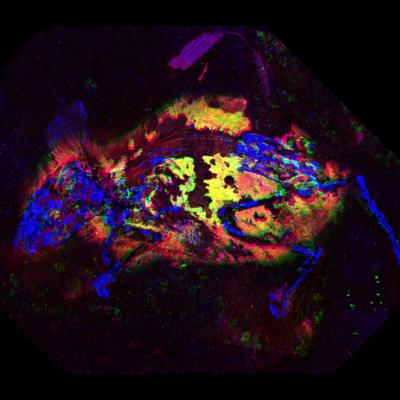A new analysis of a 3 million-year-old mouse fossil shows we may be on the path to knowing if the right fossil ever comes along, though. Used X-ray spectroscopy and multiple imaging techniques, X-ray beams from SLAC's Stanford Synchrotron Radiation Lightsource (SSRL) and the Diamond Light Source (DLS) in the U.K., to detect the delicate chemical signature of pigments in a long-extinct mouse, researchers were able to discover chemical traces of red pigment in an ancient mouse fossil, a species that roamed the fields of what is now the German village of Willershausen around 3 million years ago.
The extinct creature had brown to reddish fur on its back and sides and had a tiny white tummy.

The mouse is approximately 7 cm long. Credit: University of Göttingen

A false color synchrotron X-ray image of the fossil chemistry. Blue represents calcium in the bones, green is the element zinc which has been shown to be important in the biochemistry of red pigment and red is a particular type of organic sulfur which cannot be imaged by traditional methods. This type of sulfur is enriched in red pigment. When combined, regions rich in both zinc and sulfur appear yellow on this image, showing that the fur on this animal was rich in the chemical compounds that are most probably derived from the original red pigments produced by the mouse. Credit: Nature Communications
Color plays a vital role in the selective processes that have steered evolution for hundreds of millions of years. But until recently, techniques used to study fossils weren't capable of exploring the pigmentation of ancient animals that is pivotal when reconstructing exactly what they looked like.
This most recent paper marks a breakthrough in the ability to resolve fossilized color pigments in long-gone species by mapping key elements associated with the pigment melanin, the dominant pigment in animals. In the form of eumelanin, the pigment gives a black or dark brown color, but in the form of pheomelanin, it produces a reddish or yellow color.





Comments